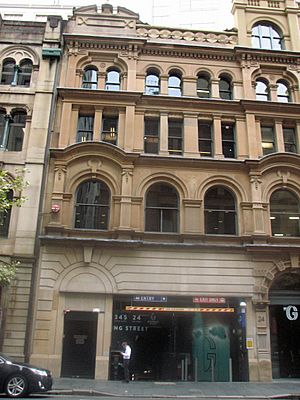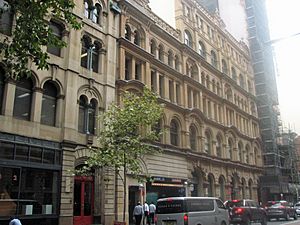22 York Street, Sydney facts for kids
Quick facts for kids 22 York Street |
|
|---|---|

22 York Street, Sydney showing the original building as it was before being incorporated with 24-26-York Street
|
|
| Location | 22 York Street, Sydney central business district, City of Sydney, New South Wales, Australia |
| Built | c. 1878 |
| Built for | Robert Gray (presumed) |
| Architectural style(s) | Victorian Romanesque |
| Official name: Warehouse (former); Building; Part of The Landmark Building Development | |
| Type | State heritage (built) |
| Designated | 2 April 1999 |
| Reference no. | 647 |
| Type | Warehouse/storage area |
| Category | Commercial |
| Lua error in Module:Location_map at line 420: attempt to index field 'wikibase' (a nil value). | |
22 York Street, Sydney is a historic building in the heart of Sydney, Australia. It used to be a warehouse, which is a large building for storing goods. Today, it is a commercial office building.
This building is located at 22 York Street in the Sydney central business district. It is now part of a larger group of buildings called the Landmark Building. Because of its history and unique design, 22 York Street was added to the New South Wales State Heritage Register on April 2, 1999. This means it is a special building protected for future generations.
Contents
History of the Site
The land where 22 York Street stands has a long history. Before European settlement, this area was the home of the Eora people. They are the traditional Indigenous Australians of the Sydney coastal region. Specifically, the Cadigal and Wangal groups of the Eora lived here. Even though many Aboriginal people were affected by the arrival of Europeans, their descendants still live in Sydney today.
The land was officially given to Thomas Wright in 1832. Later, in 1873, it was sold to Robert Gray, who was a warehouse owner. We believe the building at 22 York Street was built around 1878. This date is even carved into the top part of the building.
Over time, the building next door, at 24-26 York Street, was expanded. It grew from four storeys to six storeys. This expansion likely happened around 1905. These buildings were later connected to a large store called Beard Watsons, which was located on George Street. Beard Watsons used these buildings until at least 1955.
What the Building Looks Like
The building at 22-26 York Street has a special design style called Victorian Romanesque. This style often includes round arches and decorative details, making it look grand and strong.
The building at No. 22 has four storeys, while Nos. 24-26 has six storeys and a basement. The main structure is made of strong brick walls. Inside, it has cast iron columns and wooden beams and floors. These columns have fancy tops, called capitals, which are very decorative.
The outside walls, called facades, were originally made of stone. They are richly decorated with tall, flat columns called pilasters and horizontal bands called string courses. The part of the building at 24-26 York Street was later covered with a smooth finish. The ground floor of No. 22 has been changed to create an entrance for cars into the Landmark building.
The original parts of the building have many beautiful details. These include carved pilasters, textured stone, and decorative shapes like swag mouldings and dentils. The top of the building has a decorative wall called a parapet and broken pediments, which are triangular shapes, often topped with urns.
Inside, the building still has its original cast iron columns and timber beams. The upper floor of Nos. 24-26 gets lots of light from large windows on the roof. The buildings at 22-26 York Street are connected to other buildings on George Street through the basement and upper levels.
Building Condition
In 1986, the ground floor of 22 York Street was completely changed as part of the Landmark building project. Today, No. 22 has modern air conditioning. At street level, a ramp was added for cars to enter the Landmark building's car park.
Overall, No. 22 is in good condition because it was recently updated. However, many of its original features are now hidden by newer materials. Some newer additions include the entry ramp, concrete links to the Landmark Building, and modern fire stairs.
Why it's a Heritage Site
22 York Street, Sydney, was officially listed on the New South Wales State Heritage Register on April 2, 1999. This means it is considered very important to the history and culture of New South Wales.
The building at 24-26 York Street is especially important because it is a very well-preserved Victorian-era warehouse. It still has many of its original parts and finishes. For many years, it was linked to the famous furniture store, Beard Watson & Co. This building helps us imagine what the streets of Sydney looked like in the Victorian era.
Studying the intact parts of 24-26 York Street can teach us a lot about how warehouses were built and used in the late 1800s and early 1900s. The sandstone facade of 22-26 York Street is very detailed and beautiful. It is almost completely original, except for some changes made at street level for No. 22. The addition to 24-26 York Street was also designed to fit in well with the original building.
This building is part of a group of many other beautiful old buildings between King and Barrack Streets. It is also one of only a few old warehouses in Sydney that still have their original cast iron columns. It's also one of the rare Victorian commercial buildings that still has its original look at street level.


